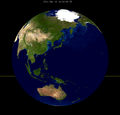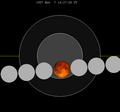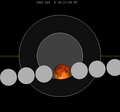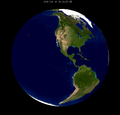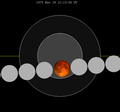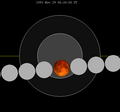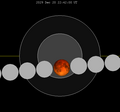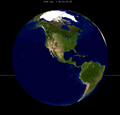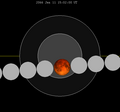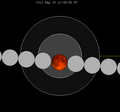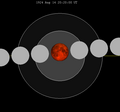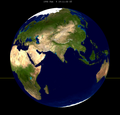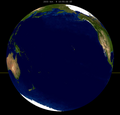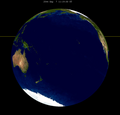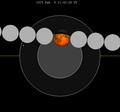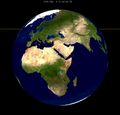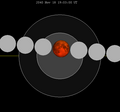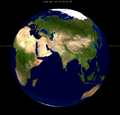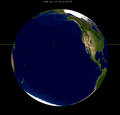Top Qs
Timeline
Chat
Perspective
December 2011 lunar eclipse
Total lunar eclipse of 10 December 2011 From Wikipedia, the free encyclopedia
Remove ads
A total lunar eclipse occurred at the Moon’s descending node of orbit on Saturday, December 10, 2011,[1] with an umbral magnitude of 1.1076. A lunar eclipse occurs when the Moon moves into the Earth's shadow, causing the Moon to be darkened. A total lunar eclipse occurs when the Moon's near side entirely passes into the Earth's umbral shadow. Unlike a solar eclipse, which can only be viewed from a relatively small area of the world, a lunar eclipse may be viewed from anywhere on the night side of Earth. A total lunar eclipse can last up to nearly two hours, while a total solar eclipse lasts only a few minutes at any given place, because the Moon's shadow is smaller. Occurring about 4.8 days after apogee (on December 5, 2011, at 20:10 UTC), the Moon's apparent diameter was smaller.[2]
Remove ads
Visibility
The eclipse was completely visible over east and northern Asia, Australia, and northern North America, seen rising over Europe and east and central Africa, and setting over North America.[3]
 |
 Hourly motion shown right to left |
 The Moon's hourly motion across the Earth's shadow in the constellation of Taurus. |
 Visibility map | ||
Images

Gallery
Asia
- Japan
- Laguna, Philippines, 13:49 UTC
- Bangkok, Thailand, 12:46-13:57 UTC
- Singapore, 14:10 UTC
- Lam Tin, Hong Kong, 14:47 UTC
- Batticaloa, Sri Lanka, 15:07 UTC
- Japan
Australia and Oceania
Europe and Middle East
- End of Lunar Eclipse from the Netherlands, 12 images merged
- Modi'in, Israel.
North America
- Peninsular Ranges of Southern California, just before moonset.
- Minneapolis, Minnesota, 13:05 UTC
- Loveland, Colorado, 13:49 UTC
- Medford, Oregon, 14:34 UTC
Timing
Summarize
Perspective
Times for Australia
The eclipse occurred on Saturday evening in Australia. Eastern Daylight Saving Time: (+11:00 UTC)
- Penumbral Eclipse Begins: 22:33:32 EDST
- Partial Eclipse Begins: 23:45:42 EDST
- Total Eclipse Begins: 01:06:16 EDST
- Greatest Eclipse: 01:31:49 EDST
- Total Eclipse Ends: 01:57:24 EDST
- Partial Eclipse Ends: 03:17:58 EDST
- Penumbral Eclipse Ends: 04:30:00 EDST
Times for India
The eclipse was visible from India in the evening, given in India Standard Time (UTC+5:30):
- Penumbral eclipse begins (P1): 17:04 IST
- Partial eclipse begins (U1): 18:16 IST
- Total eclipse begins (U2): 19:36 IST
- Mid-eclipse: 20:02 IST
- Total eclipse ends (U3): 20:27 IST
- Partial eclipse ends (U4): 21:48 IST
- Penumbral eclipse ends (P4): 23:00 IST
Times for North America
The eclipse was visible on Saturday morning before sunrise over North America. For most locations, the moon set before full lunar eclipse. Only Alaska and northernmost Canada will be able to witness the entire event.
Remove ads
Eclipse details
Shown below is a table displaying details about this particular lunar eclipse. It describes various parameters pertaining to this eclipse.[4]
Remove ads
Eclipse season
This eclipse is part of an eclipse season, a period, roughly every six months, when eclipses occur. Only two (or occasionally three) eclipse seasons occur each year, and each season lasts about 35 days and repeats just short of six months (173 days) later; thus two full eclipse seasons always occur each year. Either two or three eclipses happen each eclipse season. In the sequence below, each eclipse is separated by a fortnight.
Remove ads
Related eclipses
Summarize
Perspective
Eclipses in 2011
- A partial solar eclipse on January 4.
- A partial solar eclipse on June 1.
- A total lunar eclipse on June 15.
- A partial solar eclipse on July 1.
- A partial solar eclipse on November 25.
- A total lunar eclipse on December 10.
Metonic
- Preceded by: Lunar eclipse of February 21, 2008
- Followed by: Lunar eclipse of September 28, 2015
Tzolkinex
- Preceded by: Lunar eclipse of October 28, 2004
- Followed by: Lunar eclipse of January 21, 2019
Half-Saros
- Preceded by: Solar eclipse of December 4, 2002
- Followed by: Solar eclipse of December 14, 2020
Tritos
- Preceded by: Lunar eclipse of January 9, 2001
- Followed by: Lunar eclipse of November 8, 2022
Lunar Saros 135
- Preceded by: Lunar eclipse of November 29, 1993
- Followed by: Lunar eclipse of December 20, 2029
Inex
- Preceded by: Lunar eclipse of December 30, 1982
- Followed by: Lunar eclipse of November 18, 2040
Triad
- Preceded by: Lunar eclipse of February 8, 1925
- Followed by: Lunar eclipse of October 10, 2098
Lunar eclipses of 2009–2013
This eclipse is a member of a semester series. An eclipse in a semester series of lunar eclipses repeats approximately every 177 days and 4 hours (a semester) at alternating nodes of the Moon's orbit.[5]
The penumbral lunar eclipses on February 9, 2009 and August 6, 2009 occur in the previous lunar year eclipse set, and the lunar eclipses on April 25, 2013 (partial) and October 18, 2013 (penumbral) occur in the next lunar year eclipse set.
Saros 135
This eclipse is a part of Saros series 135, repeating every 18 years, 11 days, and containing 71 events. The series started with a penumbral lunar eclipse on April 13, 1615. It contains partial eclipses from July 20, 1777 through October 28, 1939; total eclipses from November 7, 1957 through July 6, 2354; and a second set of partial eclipses from July 16, 2372 through September 19, 2480. The series ends at member 71 as a penumbral eclipse on May 18, 2877.
The longest duration of totality will be produced by member 37 at 106 minutes, 13 seconds on May 12, 2264. All eclipses in this series occur at the Moon’s descending node of orbit.[6]
Eclipses are tabulated in three columns; every third eclipse in the same column is one exeligmos apart, so they all cast shadows over approximately the same parts of the Earth.
Tritos series
This eclipse is a part of a tritos cycle, repeating at alternating nodes every 135 synodic months (≈ 3986.63 days, or 11 years minus 1 month). Their appearance and longitude are irregular due to a lack of synchronization with the anomalistic month (period of perigee), but groupings of 3 tritos cycles (≈ 33 years minus 3 months) come close (≈ 434.044 anomalistic months), so eclipses are similar in these groupings.
Inex series
This eclipse is a part of the long period inex cycle, repeating at alternating nodes, every 358 synodic months (≈ 10,571.95 days, or 29 years minus 20 days). Their appearance and longitude are irregular due to a lack of synchronization with the anomalistic month (period of perigee). However, groupings of 3 inex cycles (≈ 87 years minus 2 months) comes close (≈ 1,151.02 anomalistic months), so eclipses are similar in these groupings.
Half-Saros cycle
A lunar eclipse will be preceded and followed by solar eclipses by 9 years and 5.5 days (a half saros).[8] This lunar eclipse is related to two total solar eclipses of Solar Saros 142.
| December 4, 2002 | December 14, 2020 |
|---|---|
 |
 |
Remove ads
See also
References
External links
Wikiwand - on
Seamless Wikipedia browsing. On steroids.
Remove ads




































